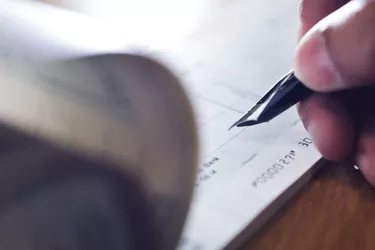
A checking account is a must for most, as it provides a safe way to pay for goods and services. When you open this type of bank account, the teller will help you to order a set of checks. While these checks come with deposit slips, they do not include any withdrawal slips. You'll have to either grab a few withdrawal slips from the bank's lobby or ask for them from the teller at the drive-thru window. Once you have a withdrawal slip, you'll need to know how to fill it out. Fortunately, this process is simple and will take just a minute or two of your time.
Filling Out a Withdrawal Slip
Video of the Day
Whether you're filling out a Wells Fargo withdrawal slip or one from another bank, you'll find the forms are pretty much the same. Start off by placing the date on the top of the slip where indicated. Next, you'll need to print your name on the line provided. There is a separate section for signing your name. GCFGlobal™ has this line in the center of their withdrawal slip, although other banks, like Baker Boyer, often place it on the bottom of the slip.
Video of the Day
Open your checking account to locate the account number. On your checks, it's the second set of numbers. The first set of numbers is your bank's routing number and you don't need that for the withdrawal slip. Finally, list how much money you'd like to withdraw from your checking account in dollars and cents.
Present the withdrawal slip to the teller in the lobby or the teller at the drive-thru window. Be prepared to show a valid ID, especially if you're new to that bank and the teller doesn't recognize you. You may also be asked to show an ID if you're withdrawing a large sum of money. Make sure you record the transaction in your check register, as you don't want to overdraw on the account.
Write a Check to Cash
If you don't have a withdrawal slip, you can still get money from your checking account by writing a check to cash. Simply write "CASH" in the "Pay to" field and then fill out the check as you normally would using the amount you'd like to get out of the account. Although optional, you may wish to list the reason for the withdrawal in the "Memo" section. Flip the check over and sign your name. Present the check to one of the tellers at your bank to receive the cash. Record the transaction in your check register before leaving the bank.
Note: Should your bank not be open when you need to withdraw the money, head to a check cashing facility. You will need to pay a fee to use the facility's services.
Visit an ATM
A second option for obtaining cash from your checking account without a withdrawal slip is through an ATM. Keep in mind that any ATM that is outside of your bank's network will charge a fee for their services. Once you visit an ATM, you'll be able to insert the debit card associated with your checking account and select the amount of money you'd like to withdraw from the account. Don't forget to list this transaction in your checking account register to avoid overdraft fees and to have an accurate picture of how much money is in your account.
Request Money Back at Checkout
A third option to withdraw cash from your checking account when a withdrawal slip isn't available is to request money back when paying for your groceries or retail purchases. Many large chains offer this service. You insert the debit card associated with your checking account into the payment processors and press "yes" when asked if you'd like to get money back. Enter the amount when prompted. Your card will then be debited the amount of the purchase plus the amount you requested in cash back. Use the receipt to record the transaction in your checking account register.